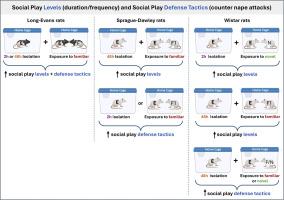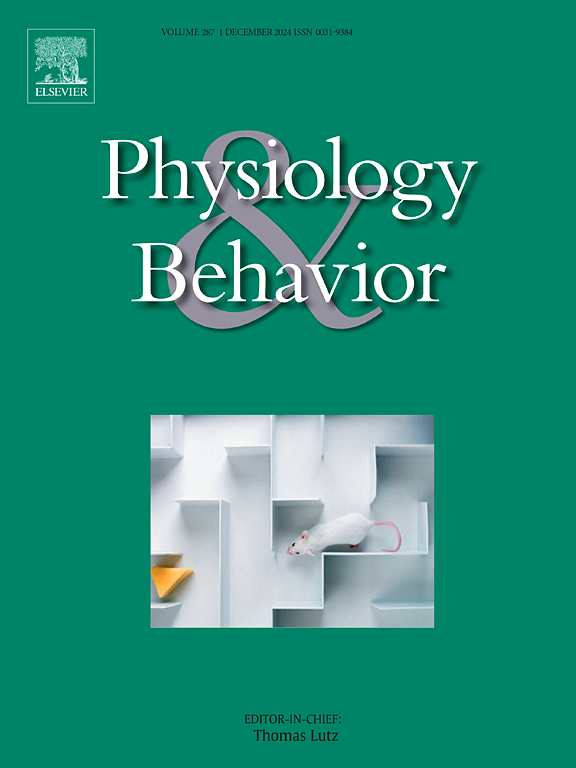玩还是不玩?社会隔离时间和刺激鼠熟悉度对三种实验大鼠社会游戏参与的影响
IF 2.5
3区 医学
Q2 BEHAVIORAL SCIENCES
引用次数: 0
摘要
许多哺乳动物的幼崽都表现出社交游戏,这对人类和老鼠的社交技能的发展至关重要。在这里,我们确定了两种外部条件,社会隔离时间和社会刺激熟悉度,如何调节三种常见实验室大鼠品系:Long-Evans, Sprague-Dawley和Wistar幼鼠的社会游戏水平(由实验动物)和社会游戏防御策略(由刺激动物)。实验大鼠被社会隔离2小时或48小时,然后在其家庭笼子中暴露给熟悉的(笼子伴侣)或新的性别,年龄和品系匹配的刺激大鼠。我们发现Long-Evans大鼠与熟悉的大鼠比与陌生的大鼠玩得更多,与隔离时间无关,Sprague-Dawley大鼠在48小时熟悉的条件下玩得最多,Wistar大鼠在2小时熟悉的条件下玩得最少。此外,Wistar大鼠比Long-Evans大鼠和Sprague-Dawley大鼠更喜欢与新型大鼠玩耍。在所分析的防御策略中,Long-Evans和Sprague-Dawley刺激大鼠在熟悉的情况下比在陌生的情况下表现出更多的反颈背攻击,Sprague-Dawley刺激大鼠在隔离2h比隔离48h后表现出更多的反颈背攻击,Wistar大鼠在隔离48h比隔离2h后表现出更多的反颈背攻击。外部条件对社会玩耍水平和防御策略的影响在性别上是相似的。总体而言,Long-Evans大鼠与一个熟悉的玩伴进行更多的社交游戏和反颈背攻击,Sprague-Dawley大鼠与一个熟悉的玩伴进行48小时(社交游戏)或2小时(反颈背攻击)隔离,Wistar大鼠与一个熟悉或新的玩伴进行48小时隔离。未来的研究可以确定神经机制的压力差异是否在这些条件诱导的社会游戏参与变化的基础上。本文章由计算机程序翻译,如有差异,请以英文原文为准。

To play or not to play? Effects of social isolation length and stimulus rat familiarity on social play engagement in three laboratory rat strains
Social play is displayed by juveniles of many mammalian species and is vital to the development of social skills as shown in humans and rats. Here, we determined how two external conditions, social isolation length and social stimulus familiarity, modulate social play levels (by the experimental animals) and social play defense tactics (by the stimulus animals) in juveniles of three common laboratory rat strains: Long-Evans, Sprague-Dawley, and Wistar. Experimental rats were socially isolated for either 2 h or 48 h and were then exposed in their home cage to a familiar (cage mate) or novel sex-, age-, and strain-matched stimulus rat. We found that Long-Evans rats played more with familiar than with novel rats, irrespective of time isolated, Sprague-Dawley rats played the most in the 48h-Familiar condition, and Wistar rats played the least in the 2h-Familiar condition. Moreover, Wistar rats played more with novel rats than Long-Evans and Sprague-Dawley rats. Among the defense tactics analyzed, Long-Evans and Sprague-Dawley stimulus rats showed more counter nape attacks with familiar than with novel rats, Sprague-Dawley stimulus rats also showed more counter nape attacks after a 2 h versus 48 h isolation while Wistar rats showed more counter nape attacks after a 48 h versus 2 h isolation. The effects of the external conditions on social play levels and defense tactics were similar across sex for the three strains. Overall, more social play and more counter nape attacks were observed with a familiar playmate in Long-Evans rats, with a familiar playmate and 48 h isolation (social play) or 2 h isolation (counter nape attacks) in Sprague-Dawley rats, and with a familiar or novel playmate after 48 h isolation in Wistar rats. Future research could determine whether strain differences in neuronal mechanisms underlie these condition-induced variations in social play engagement.
求助全文
通过发布文献求助,成功后即可免费获取论文全文。
去求助
来源期刊

Physiology & Behavior
医学-行为科学
CiteScore
5.70
自引率
3.40%
发文量
274
审稿时长
47 days
期刊介绍:
Physiology & Behavior is aimed at the causal physiological mechanisms of behavior and its modulation by environmental factors. The journal invites original reports in the broad area of behavioral and cognitive neuroscience, in which at least one variable is physiological and the primary emphasis and theoretical context are behavioral. The range of subjects includes behavioral neuroendocrinology, psychoneuroimmunology, learning and memory, ingestion, social behavior, and studies related to the mechanisms of psychopathology. Contemporary reviews and theoretical articles are welcomed and the Editors invite such proposals from interested authors.
 求助内容:
求助内容: 应助结果提醒方式:
应助结果提醒方式:


